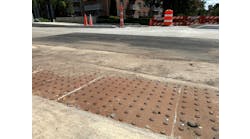When Vestas Wind Systems, a company specializing in the siting and construction of wind energy farms, sought to capitalize on the winds of eastern Oregon and Washington, it faced a logistical challenge. Vestas needed to transport 127 wind turbines from the Port of Vancouver, Wash., nearly 300 miles to the Wild Horse Wind Power Project north of Yakima in Ellensburg, Wash.
The safest and most efficient route for the project involved traveling 150 miles on I-84 through Oregon. Luckily, Vestas was able to call upon a powerful resource for success—the Oregon Department of Transportation.
Catching wind of an idea
ODOT regularly provides guidance and leadership to maintain safety on the road while moving goods efficiently. In this case, the agency called upon its expert staff in over-dimensional shipping and issues of mobility. The staff looked at matters such as bridge and highway load restrictions, tunnel and overpass height clearance and highway and road traffic management. And they worked closely with the shipping company, Wilhelm Trucking & Rigging Co., to coordinate their activities.
Additional trucking companies, such as local firms Gresham Transfer and ATS, and major movers, such as Turner Bros., Intermountain Rigging and others, have become important players in transporting the oversize windmill components.
Now, five years after the Oregon Legislature dedicated $1.3 billion of the third Oregon Transportation Investment Act to repair or replace 365 of the state’s highway bridges, the close coordination between shipping companies and ODOT is proving beneficial. The OTIA III State Bridge Delivery Program effectively doubled the volume of ODOT work. However, despite the unprecedented levels of highway construction—88 bridges are currently under construction and another 73 have been completed and open to traffic—the agency has kept freight and commuter traffic moving.
“We’ve moved a lot of large items before, such as bridges and boats,” said Doug Hedlund, ODOT Over-Dimensional Permit Unit and freight mobility manager. “What is unique about this situation is the repetitive nature of the shipping. With the bridges and the boats, those large loads are moved once. With the windmills, there are large loads moving every day of the week.”
Other challenges for transporting the windmills include determining when and where the most traffic is on the highway and creating a shipping schedule that avoids the most congested times and areas.
“For this project we invoked a new discipline,” said Gregg Dal Ponte, ODOT Motor Carrier Transportation Division Administrator. “We went through and graphed traffic data day by day and by the hour. From there we looked for the highs and lows of the traffic flows to determine the best time to move the parts. If sending a shipment doesn’t create a huge issue with the traffic, then it goes.”
During the busy 2006 summer construction season, ODOT facilitated the transport of 1,047 individual loads to deliver the windmill components from the Port of Vancouver to the Wild Horse Wind Power Project. Nearly 1,000 of the 1,047 loads required permits, but most of them did not need special permitting; the weight could be distributed so the total cargo fell within the guidelines, or load rating tables, that ODOT uses to calculate how much freight a bridge can bear.
When a load did exceed the weight tables, Bill Spofford, program coordinator for the Over-Dimensional Permit Unit, and Bert Hartman, bridge program managing engineer in ODOT’s Bridge Engineering Section, along with a team of four load raters, entered the picture to calculate how to redistribute the load and issue special permits. They figured out ways to distribute the weight evenly so that the supporting structures “shared” the load and minimized the effect of heavy freight on a given bridge, for example, by directing the freight company to use a route over a column or over a lane that runs between two steel girders.
Turning the turbines
Though the word “windmill” may evoke picturesque scenes of Holland, the wind turbines of the 21st century are generations ahead in size and power. The physical dimensions of a single wind turbine are awe-inspiring. Each is composed of a tower, a rotor of three wind blades and a generator system called a “nacelle.” During the past five years, the average size and weight of the already large turbine components has increased by 40%; now, each nacelle weighs 250,000 lb.
Transporting each nacelle requires a vehicle more than 220 ft long, comprising a truck, a jeep, a semitrailer, a booster axle—another trailer—and a non-load-bearing truck. The tower, when erected, stands more than 220 ft tall. It splits into three segments for transport; when assembled, a tower can weigh as much as 450,000 lb. Even the rotors are transportation challenges: Each wind blade is more than 60 ft long and weighs more than 12 tons.
This project includes some of the largest and heaviest nacelles built, with the weight of the load and the equipment equaling approximately 400,000 lb. The extra weight has to be distributed across numerous axles; for 250,000 lb, 19 are required. The more the weight is distributed across many axles, the less strain the load puts on the bridge below.
Take these numbers for one wind turbine, multiply them by 127 and it’s easy to see how overwhelming a hauling challenge this project would be without expert guidance.
While traveling I-84, the components passed safely over 21 bridges in the Columbia River Gorge National Scenic Area slated for repair or replacement through ODOT’s bridge program. Construction on these projects will peak in 2008 to 2010. Vestas will still be transporting windmills at that time, and ODOT is already planning how to handle the shipments smoothly during construction.
To help predict how the long, wide trucks would move through the curving highways and constricted bridge work zones, ODOT gathered information from truck drivers and created a customized template to use with special software normally used for determining how much room unusual vehicles such as aircraft and fire engines need to turn.
“Mobility is a closely coordinated activity that takes place up front,” Dal Ponte said. “Concrete barriers used during construction, for example, may not accommodate an extra-long load like a windmill blade, so we used the template for how an unusual vehicle moves and turns to lay out the traffic control.”
As the oversize windmill components move across the highway, ODOT is committed to both passenger and commercial access to roads and bridges.
As more windmills are scheduled to travel through Oregon in the future, ODOT will be ready for the challenge.


